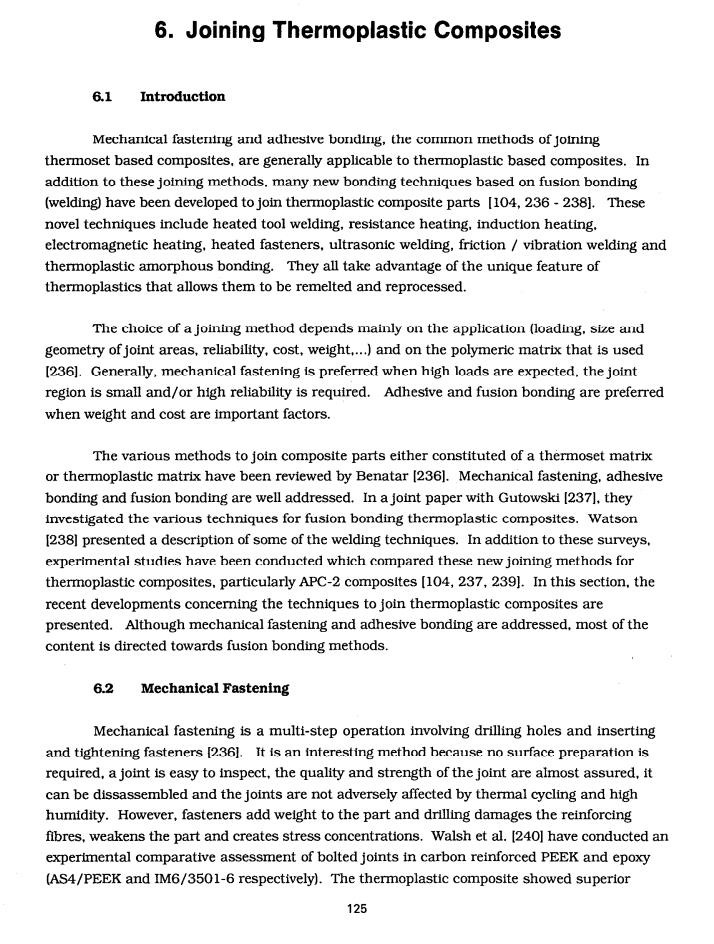正在加载图片...

6.Joining Thermoplastic Composites 6.1 Introduction Mechanical fastening and adhesive bonding,the commnon methods of joining thermoset based composites,are generally applicable to thermoplastic based composites.In addition to these joining methods.many new bonding techniques based on fusion bonding (welding)have been developed to join thermoplastic composite parts [104,236-238].These novel techniques include heated tool welding.resistance heating.induction heating. electromagnetic heating.heated fasteners,ultrasonic welding,friction vibration welding and thermoplastic amorphous bonding.They all take advantage of the unique feature of thermoplastics that allows them to be remelted and reprocessed. The choice of a joining method depends mainly on the application (loading,size and geometry of joint areas,reliability,cost,weight,...)and on the polymeric matrix that is used [236].Generally.mechanical fastening is preferred when high loads are expected.the joint region is small and/or high reliability is required.Adhesive and fusion bonding are preferred when weight and cost are important factors. The various methods to join composite parts either constituted of a thermoset matrix or thermoplastic matrix have been reviewed by Benatar [2361.Mechanical fastening.adhesive bonding and fusion bonding are well addressed.In a joint paper with Gutowski [2371.they investigated the various techniques for fusion bonding thermoplastic composites.Watson [238]presented a description of some of the welding techniques.In addition to these surveys. experimental studies have been conducted which compared these new joining methods for thermoplastic composites,particularly APC-2 composites [104,237,239].In this section,the recent developments concerning the techniques to join thermoplastic composites are presented.Although mechanical fastening and adhesive bonding are addressed,most of the content is directed towards fusion bonding methods. 6.2 Mechanical Fastening Mechanical fastening is a multi-step operation involving drilling holes and inserting and tightening fasteners [2361.It is an interesting method because no surface preparation is required,a joint is easy to inspect,the quality and strength of the joint are almost assured,it can be dissassembled and the joints are not adversely affected by thermal cycling and high humidity.However,fasteners add weight to the part and drilling damages the reinforcing fibres,weakens the part and creates stress concentrations.Walsh et al.[240]have conducted an experimental comparative assessment of bolted joints in carbon reinforced PEEK and epoxy (AS4/PEEK and IM6/3501-6 respectively).The thermoplastic composite showed superior 1256. Joining Thermoplastic Composites 6.1 Introduction Mechanical fastening and adhesive bonding, the common methods of joining thermoset based composites, are generally applicable to thermoplastic based composites. In addition to these joining methods, many new bonding techniques based on fusion bonding (welding) have been developed to join thermoplastic composite parts [ 104, 236 - 2381. These novel techniques include heated tool welding, resistance heating, induction heating, electromagnetic heating, heated fasteners, ultrasonic welding, friction / vibration welding and thermoplastic amorphous bonding. They all take advantage of the unique feature of thermoplastics that allows them to be remelted and reprocessed. The choice of a joining method depends mainly on the application (loading, size and geometry ofjoint areas, reliability, cost, weight,...) and on the polymeric matrix that is used [236]. Generally, mechanical fastening is preferred when high loads are expected, the joint region is small and/or high reliability is required. Adhesive and fusion bonding are preferred when weight and cost are important factors. The various methods to join composite parts either constituted of a thermoset matrix or thermoplastic matrix have been reviewed by Benatar [236]. Mechanical fastening, adhesive bonding and fusion bonding are well addressed. In a joint paper with Gutowski 12371, they investigated the various techniques for fusion bonding thermoplastic composites. Watson 12381 presented a description of some of the welding techniques. In addition to these surreys, experimental studies have been conducted which compared these new joining methods for thermoplastic composites, particularly APC-2 composites [104, 237, 2391. In this section, the recent developments concerning the techniques to join thermoplastic composites are presented. Although mechanical fastening and adhesive bonding are addressed, most of the content is directed towards fusion bonding methods. 6.2 Mechanical Fastening Mechanical fastening is a multi-step operation involving drilling holes and inserting and tightening fasteners (2361. It is an interesting method because no surface preparation is required, a joint is easy to inspect, the quality and strength of the joint are almost assured, it can be dissassembled and the joints are not adversely affected by thermal cycling and high humidity. However, fasteners add weight to the part and drilling damages the reinforcing ilbres, weakens the part and creates stress concentrations. Walsh et al. [240] have conducted an experimental comparative assessment of bolted joints in carbon reinforced PEEK and epoxy (AS4/PEEK and IM6/3501-6 respectively). The thermoplastic composite showed superior 125